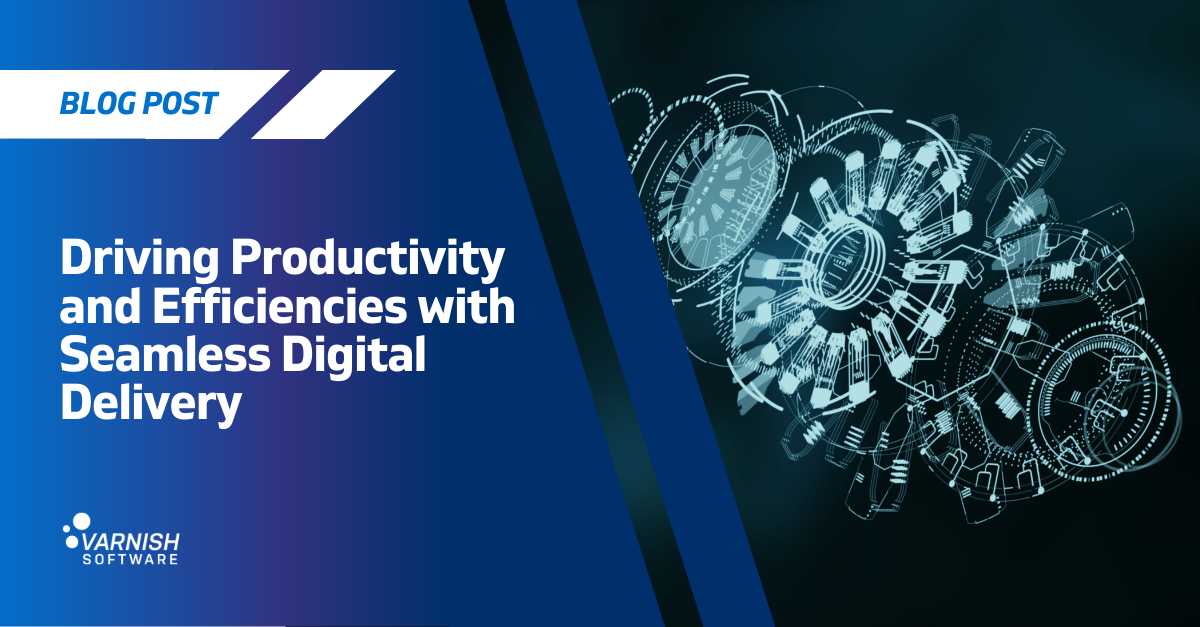Digital processes and data transfer are the backbone of day-to-day operations for enterprises everywhere. With digital transformation, teams get more done. From processing orders, analyzing data, delivering content and running internal and external portals, the aim is streamlined digital systems that support business productivity.
This is a challenge. In large organizations, hundreds or thousands of employees can need access to the same services at once, pulling the same data. This demand causes bottlenecks, performance losses, and delays in workflows. The result? Increased complexity, lost productivity and added costs. It also causes platform instability, diverting precious operational resources from revenue-generating tasks in order to remediate issues.
Two effective ways to protect the productivity of teams in a digital environment are:
- Reduce latency, for faster access to applications and data
- Reduce operational overheads to free up resources
Reduce Latency for Faster Access to Applications and Data
For many enterprises speed, reliability and usability are business critical. Bottlenecks, performance degradation or platform instability can hinder productivity, while reducing network latency improves user experience and gives businesses a competitive edge. Three standard approaches to latency reduction are:
Implement caching. Cache and deliver data from nearby servers, minimizing the distance data needs to travel. Using and modifying HTTP caching headers also helps control what is cached and how long to keep it in cache for, helping drive caching efficiency and boost hit rates.
Reduce payload size. Compress response data using techniques like Gzip and convert images to WebP to reduce the size of transmitted data and speed up delivery.
Load balancing. Distribute incoming traffic evenly across instances to ensure optimal performance.
Varnish is powerful and platform-agnostic caching software which includes capabilities for compression and flexible load balancing. What are some other features of Varnish Enterprise that support low-latency collaboration and agile delivery?
Request Coalescing: When Varnish receives multiple requests for the same uncached content, it only sends one request to the backend and then satisfies all waiting requests in parallel.
Content Streaming: When Varnish receives a request for an uncached large file, it can stream the content to the client while simultaneously storing it in cache. End-users don’t have to wait until the entire file is cached before receiving data, resulting in much faster response times.
Connection Pooling: Opening connections to backends comes at a cost, so Varnish pools backend connections by default. Re-using existing connections can reduce latency, so when a backend task finishes the connection is not closed but added to a pool for reuse.
Cache Invalidation: Execute thousands of cache purges in milliseconds, ensure cached objects are fresh and out-of-date objects removed, to boost cache hit rates.
Persisted Disk Caching: Extend caching capacity in a cost-effective way, for more cache hits, efficient use of resources and less time waiting for cache refills.
Reduce Operational Overheads And Maintenance Time
Faster access to digital systems is one thing, but it doesn’t count for much if the systems are unstable, unreliable or overly complex to manage. One thing we find with Varnish Enterprise customers is that after Varnish solves their speed and efficiency issues, they also discover significant reductions in overheads: Varnish is incredibly stable, even under pressure. With extensive logging and monitoring capabilities, it’s also easy to maintain, optimize and scale, while load balancing and disk storage protect origins from excessive traffic.
We can take three case studies in time savings with Varnish to illustrate these cost-saving benefits:
- The Hindu: Greater efficiency with automated cache invalidation
India’s hugely popular newspaper The Hindu uses Varnish for its online news site, making frequent changes to their caching logic. Automating high-frequency cache invalidation using Varnish Controller and the Varnish Enterprise feature Ykey saves their engineering team from having to perform cache invalidation tasks manually, saving time and costs and enabling focus on more valuable projects. Varnish Controller also significantly reduces the time needed for managing changes across both production and non-production environments.
- Nowcom: Improved storage saves 100 hours of work
Nowcom, the automotive and financial services technology company, uses Varnish Enterprise for front- and backend caching. Varnish Enterprise’s persistent disk storage feature, Massive Storage Engine (MSE), helped Nowcom achieve 10x more local cache storage without extra maintenance overheads or stability issues. The reliability of MSE saves Nowcom more than 100 hours a year on production issues, site failover problems and testing efforts.
- Future Publishing: One week of work saved in just three months
Before deploying Varnish Enterprise, the Future Publishing engineering team had at least one, on-call incident per week, each one taking three to fours hours to resolve. In the first three months with Varnish Enterprise, they had no outages at all, and had already saved at least one work week in working hours, thanks to the stability of Varnish. A significant time and cost saving!
At times when businesses are looking to reduce costs, without reducing their ability to execute plans and reach growth targets, the implementation of content delivery software offers a multi-faceted solution.
Varnish Enterprise caches anything HTTP, like web content, images, APIs, video and more, and speeds up digital interactions to benefit all teams in the business. It’s a software-based approach that slots right into existing architectures and processes, offering greater stability for digital processes. While the rest of the business enjoys seamless interactivity and data transfer, DevOps and IT teams love Varnish for the reliability it provides. If cost reduction and productivity gains are top of mind for your business, talk to a Varnish expert and let’s see if we can help.
/VS-logo-2020-197x60.png?width=136&height=60&name=VS-logo-2020-197x60.png)




